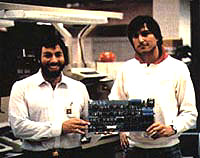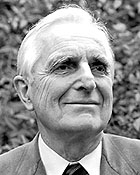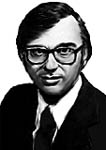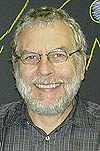Jobs, Woz lead Class of 2000
Dell, Engelbart, Turing round out top vote-getters; Bushnell, Hoff, Kilby, Lovelace and Roberts selected by Committee
 Steve Wozniak (left) and
Steve Jobs, circa 1975
Steve Wozniak (left) and
Steve Jobs, circa 1975 |
The class of 2000 -- our third round of inductees -- is a distinguised list of pioneers and innovators, without whose contributions today's computer industry would be unrecognizable.
Leading the class are the two computer whiz kids who set corporate America
on its ear when they founded Apple Computing a quarter-century ago. It's
only appropriate that Steve Jobs and Steve Wozniak are being inducted together,
voted No. 1 and 3 by the public, respectively, in online voting over the
summer.
 Doug Engelbart
Doug Engelbart
Doug Engelbart, who invented both the computer mouse and using windows on
a computer desktop for displaying information, came in No. 2. Engelbart's
mouse and windows both were developed in the 1960s, a full decade and a
half before they would see widespread acceptance.
 Alan Mathison Turing
Alan Mathison Turing
Michael Dell, who developed the concept of selling personal computers via mail-order and revolutionized the way computers are sold (while also helping to drive the price of PCs down), was selected fourth by voters.
Rounding out this year's publicly selected inductees is the late Alan Mathison
Turing, who designed the Turing Machine in the years before World War II
and then helped crack the Nazis' Enigma code during the war, saving untold
lives and hastening the war's end.
 Michael Dell
Michael Dell
Selected by the Computer Museum of America's Hall of Fame Committee were Lady Ada Augusta Lovelace, Nolan Bushnell, Marcian E. "Ted" Hoff, Jack St. Clair Kilby and Ed Roberts.
Lady Lovelace was the sponsor of pioneer Charles Babbage (inducted into
the Hall of Fame in 1998), the 19th century inventor of the Difference and
Analytical Engines, the earliest direct progenitors of modern computers.
It was Lovelace who first realized that by using punch cards (then popular
with the Jacquard looms of the day), Babbage could program his machines
to perform different tasks.
 Jack St. Clair Kilby
Jack St. Clair Kilby
Jack St. Clair Kilby is best known for his 1958 development of the integrated
circuit -- a single board with two transistors on it -- at Texas Instruments.
But he was also leader of the team that built the first ever hand-held electronic
calculator in 1967.
 Lady Ada Augusta Lovelace
Lady Ada Augusta Lovelace
M.E. "Ted" Hoff was an engineer at Intel in 1971 when he developed the first ever programmable integrated circuit, or CPU (for central processing unit). The Intel 4004 was the direct ancestor of the PowerPC and Pentium III chips powering today's personal computers.
Nolan Bushnell quit his job as an engineer at Ampex, a stereo and electronics
giant, in 1970 to design Computer Space, the first commercial videogame.
While Computer Space was a flop, Bushnell's next game, PONG, took the world
by storm. Soon there was a home version to rival the Magnavox Odyssey, and
Bushnell founded a new company, Atari, to market his new family of videogames.
 M.E. "Ted" Hoff
M.E. "Ted" Hoff
If it weren't for Ed Roberts, one of our 1998 inductees might never have
made it into the Computer Hall of Fame. It was Roberts' Altair home computer,
launched in December 1974, that led to the personal computer revolution
that continues today. Roberts' Altair wasn't the first PC, but it was the
first to capture the public's fancy. And a young man studying at Harvard
by the name of Bill Gates was inspired by Roberts' new computer to go into
programming. Gates wrote a version of BASIC for the Altair, and started
a new company with boyhood friend Paul Allen to market it: Microsoft.
 Nolan Bushnell
Nolan Bushnell
The Computer Hall of Fame and Computer
Museum of America congratulate this year's distinguished and accomplished
list of inductees. The Computer Hall of Fame is located at the Computer
Museum of America at Coleman College in La Mesa, California (near San
Diego).
© 2000 Computer Hall of Fame, Computer Museum of America. All rights reserved.